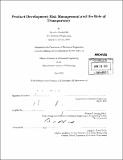Product development risk management and the role of transparency
Author(s)
Olechowski, Alison L. (Alison Louise)
DownloadFull printable version (15.33Mb)
Other Contributors
Massachusetts Institute of Technology. Dept. of Mechanical Engineering.
Advisor
Warren P. Seering.
Terms of use
Metadata
Show full item recordAbstract
Risks in product development lead to schedule and cost over-runs and poor product quality. While numerous risk management frameworks have been published and research on specific risk management practices and methods has been conducted, there is little understanding of what the key characteristics of successful risk management in product development are. This research consists of two phases: an empirical study of the best practices in product development risk management, and a qualitative study of the role of transparency in the same. The results of a survey of over 200 product development practitioners in industry were analyzed. Of the 170 practices from the literature addressed in the survey, 36 best practices in product development risk management were identified. These best practices were categorized in to six groups: 1- Risk Management Personnel and Resources; 2- Tailoring and Integration of the Risk Management Process; 3- Risk-based Decision Making; 4- Specific Mitigation Actions; 5- Monitoring and Review, and; 6- ISO 31000 Principles. The best practices in these categories show strong evidence not only for achieving effective risk management, but also the ability to positively affect overall project stability and the achievement of the project cost, schedule, performance and customer satisfaction targets. All eleven of the ISO 31000:2009 Risk Management Standard principles (ISO 2009b) were found to be best practices of product development risk management, suggesting the standard is applicable to product development The practice with the highest correlation with product development success was found to be one of the eleven ISO principles: "risk management is transparent and inclusive." The second phase of this research aimed to qualitatively validate the observed correlation between transparency and product development success, through twelve semi-structured interviews with product development practitioners from industry. Transparency was found to be an essential feature of product development risk management Transparency of risk management is beneficial to product development in many ways: it is a vehicle for an accurate shared representation of the current state of the product development project, it facilitates stakeholder collaboration; it is a means of aligning efforts towards critical tasks. Requirements for and barriers to transparency were also explored. These results not only inform current product development practitioners on where to focus risk management efforts, but also contribute an empirical evaluation of the impact of specific risk management practices on product development success.
Description
Thesis (S.M.)--Massachusetts Institute of Technology, Dept. of Mechanical Engineering, 2012. Cataloged from PDF version of thesis. Includes bibliographical references (p. 73-77).
Date issued
2012Department
Massachusetts Institute of Technology. Department of Mechanical EngineeringPublisher
Massachusetts Institute of Technology
Keywords
Mechanical Engineering.